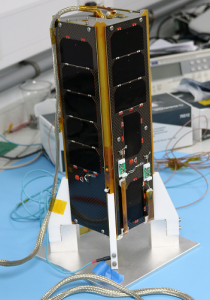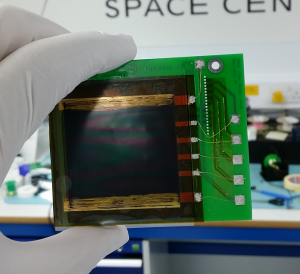
The Centre for Solar Energy Research was selected to take part in the UK Space Agency’s September 2016 CubeSat mission. The AlSat Nano is a joint space mission between the UK Space Agency and Algerian Space Agency (ASAL). CSER’s successful selection, following a presentation to the UK Space Agency in Swindon by Dr Dan Lamb (project leader), offered a fantastic opportunity to “flight test” their innovative Thin Film Solar Cell. The programme was committed to a tight time schedule and CSER in partnership with the University of Surrey delivered their payload to the CubeSat manufactures by September 2015. September 26th 2016 saw the successful launch of the AlSat Nano with the Thin Film Solar Cell payload on-board. Now its performance will be systematically measured and the data beamed down to mission control. The CubeSat is expected to generate data for at least one year which will be invaluable for producing high quality publications, securing further funding for the research and promoting Swansea University’s contribution to space science.

This space experiment arose from CSER’s EPSRC funded research project aimed at developing a new solar cell technology for use in Space. In collaboration the University of Surrey and industrial partners Qioptiq Space Technology (QST) and Surrey Satellite Technology Ltd the development of the project developed a new solar cell technology to meet the emerging demands of large area solar array space applications.
CSER’s Cadmium Telluride thin film solar cell was directly deposited onto a cerium-doped cover glass which is just 1/10th of a millimetre thick. This cover glass is space qualified, designed to withstand the intense radiation environment and is the standard protective cover on solar panels for satellites. QST are the World’s sole supplier of this product; any solar cells destined for extraterrestrial use must have this glass bonded to the illuminated surface. The cover glass absorbs the high intensity radiation that would otherwise darken any standard glass and damage the semiconductor layers making-up the solar cells.
CSER’s innovative step uses its expertise in semiconductor thin films, to deposit the thin films for the solar cell directly onto the cover glass thus saving on the weight and cost of also having to use a substrate material.
- The cover glass is flexible allowing it to be “rolled up” before and after the solar cell is applied to it.
- This flexibility enables a cost-reducing roll-to-roll manufacturing process
- A flexible solar cell technology for space will enable new pathways for the stowage and subsequent deployment

